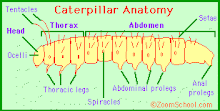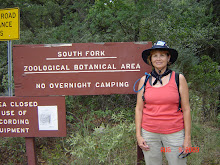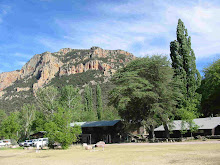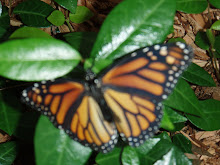Today, Angela taught Jared, Jenny, and myself how to dissect frozen caterpillars. This is the focus of Angela's research at Wesleyan University. Her research is focused on whether parasitism is reduced in caterpillars that have an increased immune system. The process is to dye clear silicon glass beads red. These glass beads range in size from 40 - 100 microns. A micron is equivalent to one millionth of a meter (10 to the negative 6 power). So these beads can only be seen under a microscope. The beads are then placed in a centrifuge soaked in Ringer solution until she is ready to inject them into live caterpillars. Ringer solution is an aqueous solution of the chlorides of sodium, potassium, and calcium in the same concentrations as normal body fluids, used chiefly in the laboratory for sustaining tissue. During dissection, the body parts can be easily observed and manipulated. This eases in the dissection process.
Angela performed the dying process and injection about 3 days ago. Once the injection takes place, there is usually an immediate response to begin the process of encapsulation. Encapsulation means to encase in or as if in a capsule. If the caterpillar has a strong immune system, it will encapsulate the bead which immitates parasitism. Remember this definition? It's when a parasitoid lays its eggs inside the host body: the caterpillar. When a foreign object is encapsulated in the caterpillar, it will not develop; thus it will die.
Angela then froze the caterpillars for at least 24 hours in separate cups with one leaf inside to it could continue to eat until it froze. We began the dissection process around 9:00 am and it continued until about 4:30 pm. We did break for lunch!
I have never performed a dissection so this was very interesting. The caterpillar is laid in a petri dish and Ringer solution is poured over it. I used forceps and a straight pin to manipulate it in the solution to assist in thawing. We were short on dissection tools so we had to improvise using the pin. A horizontal cut is made on the dorsal side under the last set of prolegs. Then a perpendicular incision is made on the center of the abdomen and continues to the neck. A caterpillar has 3 pairs of thoracic legs that protrude from the thorax. The rest of the legs are called prolegs. These legs assist in locomotion. Please refer to the diagram and for further explanation of the anatomy of a caterpillar, please click the link.
I then used the forceps to remove the intestines and all other materials in search of the beads. If they have been encapsulated, they will turn very dark. However, I found several beads in my caterpillars that had red beads which is an indication that the caterpillar did not reject the foreign object by encapsulation. It is very difficult searching for these tiny beads. Even with the use of the microscope, they are difficult to locate. Angela doubled checked all of our petri dishes and she discovered we were becoming dissection experts. She rarely found additional beads in our dishes. This was very rewarding and made all of us feel very important!
At this point, Angela placed the beads located in one caterpillar into a microcentrifuge tube and labeled the date, number of beads, and species. She will enter the data into a Microsoft Excel spreadsheet at a later date.
All the while, Junko, Suoko, and Natalie were doing "zoo" which is removal of fras and collecting and feeding plant material to the caterpillars. The zoo is located in the same lab as the dissection.
When they have interesting cats. or find an unusual pupa, we take pictures for ourselves.
In another lab next door, some team members were assisting Dave with identification of his general collection. A general collection means you collect caterpillars and do not have to count the leaves when you beat the bushes. Dave is using his data to write another caterpillar book. Lee and Angela, however, are doing research with their specific collection.
Tomorrow is our last morning to finish with dissecting the 8 remaining specimens for Angela. Lee wants some team members to check the photographs of the collections made this week. A quick "zoo" will be performed which means to check for pupae and remove fras. Lee has already made arrangements for a SWRS volunteer to finish rearing the caterpillars. Once hatched out, they will be placed into the freezer. Lee will return next year to collect the data. We also have to clean up the labs we have used and store equipment and materials into a locker. When we arrived, all the equipment was out, so we don't know this process, but we'll learn.
We will eat breakfast and lunch at the research station. Then we will begin our 3 hour drive to Tucson to spend our last night together in a debriefing by Lee. He will also provide us with our last meal sponsored by Earthwatch. This has been an experience I won't forget for a long time to come. Until tomorrow......
Wednesday, August 12, 2009
Subscribe to:
Post Comments (Atom)







































Hey Girl,
ReplyDeleteThis is truly an amazing experience for you!!! I am overwhelmed with the information that you are learning and what you are actually doing in the field. This is such a wonderful opportunity! I can't wait to see how you are going to incorporate this experience in your science lessons - I am so excited. See you in a few days. Love ya and be careful of those hairy spiders. Robyn :)